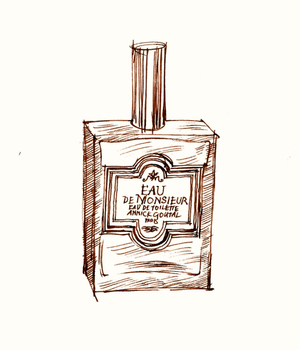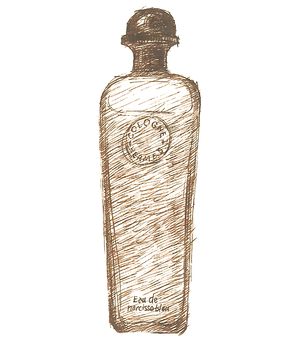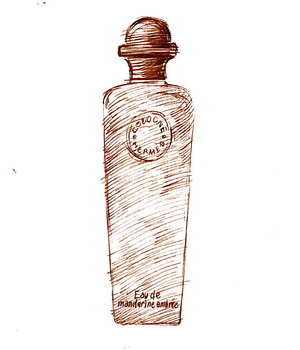Tagged With ‘2013’
Annick Goutal
Eau de Monsieur
26 March, 2015
 Mention the name Annick Goutal and the first scent that springs to mind is Eau d’Hadrien, the intensely lemony, slightly hair-sprayish scent that was launched in 1981 and went on to become the company’s best-seller.
Mention the name Annick Goutal and the first scent that springs to mind is Eau d’Hadrien, the intensely lemony, slightly hair-sprayish scent that was launched in 1981 and went on to become the company’s best-seller.
But before Eau d’Hadrien came Eau de Monsieur. Launched in 1980, discontinued for a while and then relaunched in 2013, it shares its lemony, eau de cologne-like zest with Eau d’Hadrien, but it’s an altogether quieter, softer fragrance.
Eau de Monsieur, like Eau d’Hadrien, is based around the zesty, zingy smell of lemons and the slightly pear-drop-lemony sweetness of lemon verbena (extracted from the leaves of a straggly South American shrub).
But while that’s pretty much the start and the finish of Eau d’Hadrien, that initial burst of sharp sweet freshness quickly fades to reveal what smells a bit like a sun-drenched Greek mountainside underneath – that scent of crushed thyme, cistus leaves and lavender, which in this case has an added touch of helichrysum, that strong-smelling everlasting flower that the French call immortelle.
Immortelle isn’t a scent that everybody loves: to me it has the richness of brandy and Christmas pudding and crackling pine-log fires, but to other people it has a medicinal TCP smell, which isn’t something you necessarily want in a perfume.
In Goutal’s fantastic Sables, released a few years later in 1985, immortelle is the main ingredient, but in Eau de Monsieur it’s used in moderation to give a subtle background sweetness. According to the list of ingredients on the Annick Goutal website, it also includes patchouli and sandalwood, which add a bit of their gentle warm woodiness to the mix, and there’s a little bit of bitterness too, which other writers have ascribed to that classic men’s-fragrance ingredient, vetiver.
It’s not, perhaps, the most original perfume out there, and it’s disappointing to discover that it only last an hour or so on the skin, but Eau de Monsieur is classy, attractive, natural-smelling and easy to wear, which is a lot more than you can say for the majority of men’s fragrances.
Hermès
Eau de Narcisse Bleu
10 October, 2014
 Pretty much everyone I know loves Hermès’ deliciously fresh and zingy Eau d’Orange Verte, so when Eau de Narcisse Bleu (literally ‘blue narcissus water’) was launched in 2013 it had a tough act to follow. As I’ve never seen a blue narcissus / daffodil, I think it’s safe to say that this perfume has an element of fantasy about it, and as a smell, too, it’s perhaps rather more complex and a little less instantly accessible than its predecessor. But give it a little time and I think it’ll grow on you.
Pretty much everyone I know loves Hermès’ deliciously fresh and zingy Eau d’Orange Verte, so when Eau de Narcisse Bleu (literally ‘blue narcissus water’) was launched in 2013 it had a tough act to follow. As I’ve never seen a blue narcissus / daffodil, I think it’s safe to say that this perfume has an element of fantasy about it, and as a smell, too, it’s perhaps rather more complex and a little less instantly accessible than its predecessor. But give it a little time and I think it’ll grow on you.
Eau de Narcisse Bleu may not have the euphoric mood-lifting freshness of Eau d’Orange Verte, but it has a gentle softness that, once you’ve smelled it for a while, is extremely appealing in its own right. It does have the faint sweetness of real daffodil flowers (try sticking your nose in one on a sunny day next March and you’ll see what I mean), but what narcissus extract smells of most, rather unexpectedly, is fresh hay. *
Now, I have nothing against smelling of hay, which is a lovely scent in its own right, but what Hermès’ much-mythologised perfumer, Jean-Claude Ellena, has done is blended the smell of hay with a whole raft of subtly complementary fragrances. Most of them are quite ‘green’ – that is, they smell fresh and natural, like grass and leaves, but not especially sweet or flower-like.
To me it has a slight but definite scent of fig-leaves, which for anyone who loves L’Artisan Parfumeur’s wonderful Premier Figuier as much as I do can only be a good thing. Whether this figginess is (excuse the pun) a figment of my imagination I’m not sure, but among the other ingredients that Ellena lists is galbanum, which is extracted from the root of a wild Iranian plant that looks a bit like fennel or cow-parsley, and indeed is distantly related to them.
Galbanum has a marvellously fresh sappy smell like newly-snapped pea-pods, and is one of the most important components of ‘green’ perfumes, but its greenness, here, is tempered by the hay-like sweetness of narcissus, with a hint of earthy bitterness underneath which manages to stop it from smelling at all girly.
If my description makes it sound a bit complicated, don’t be put off, for it’s such a well-blended perfume that there’s nothing discordant about it. In fact if anything it is, perhaps, a little too gentle for its own good, as it’s a ‘quiet’, thoughtful scent that stays close to your skin and doesn’t, on the whole, grab other people’s attention. It’s discreet and refined, in other words, rather than a ‘look-at-me’ perfume, which is perfect if you want to smell good without drawing attention to yourself. Go try it.
* I say ‘narcissus extract’, but one of the irritating things about perfume marketing is how vague – and frankly clueless – most descriptions of perfume ingredients actually are. For as anyone who actually grows the things themselves knows full well, a bright-yellow daffodil like Narcissus ‘February Gold’ smells very different to Narcissus papyraceus, the so-called paperwhite narcissus; the former has a gentle, hay-like scent, while one of the big selling-points of paperwhites is their powerful, almost jasmine-like perfume, the sweetness of which, en masse, can have a touch of the slightly repellent stagnant-water smell that perfumers refer to as ‘indolic’. If only perfume PRs were taught some basic botany.
Postscript – mystery solved, but only by going to the source: in France last week I visited IFF-LMR, the legendary natural raw perfume materials company near Grasse, and what should we get talking about but their narcissus extract, which is derived from the beautiful Narcissus poeticus, fields of which grow wild in the uplands of the Lozère. Did they use other species of daffodil as well? No, came the answer, and it’s their extract that you’re smelling (among many other things) in Eau de Narcisse Bleu.
Hermès
Eau de Mandarine Ambrée
1 June, 2014
 Now this is fun. Eau de Mandarine Ambrée isn’t perhaps the most sophisticated perfume in the world, but it’s a jolly, cheering little scent, that smells sweet and zesty and pretty much exactly like mandarin juice when you first spray it on. It was launched in 2013, at the same time as Eau de Narcisse Bleu, and brings the number of Hermès colognes up to five (the other three being Eau d’Orange Verte, Eau de Gentiane Blanche and Eau de Pamplemousse Rose).
Now this is fun. Eau de Mandarine Ambrée isn’t perhaps the most sophisticated perfume in the world, but it’s a jolly, cheering little scent, that smells sweet and zesty and pretty much exactly like mandarin juice when you first spray it on. It was launched in 2013, at the same time as Eau de Narcisse Bleu, and brings the number of Hermès colognes up to five (the other three being Eau d’Orange Verte, Eau de Gentiane Blanche and Eau de Pamplemousse Rose).
Like all the more recent Hermès perfumes it was created by Jean-Claude Ellena, whose celebrity status says much about how the industry has changed over the last decade or so – in the past no one would have known his name. His perfumes are nearly always interesting, if not always terrifically commercial, and Hermès seem to have given him licence (if you’ll forgive the pun) to follow his own nose and see where it takes him, especially with the colognes and it Hermessences range – see my review of Vétiver Tonka.
Ellena is very interested in food, and like quite a few of his perfumes, Eau de Mandarine Ambrée reminds me of cooking smells: nice cooking smells, that is. In this case it reminds me of the ugli-fruit marmalade that Roy made this year, which is very nice in its own way, but lacks the tartness of Seville-orange marmalade, and tastes a bit too sweet and jammy as a result.
Still, you could do far worse than start your day with Eau de Mandarine Ambrée. It’s light and refreshing and puts a smile on your face, yet it’s longer-lasting than most citrus-based colognes. This seems to be because Ellena has combined mandarin with a bit of passion-fruit extract and what’s known in the perfume trade as amber (thus Mandarine Ambrée).
‘Amber’ is one of those confusing terms that gives perfumery a bad name: it’s nothing to do with amber, the fossilised resin, or ambergris, the strange waxy lumps that whales occasionally cough up after swallowing too many cuttlefish (I kid you not), which develop a wonderful aroma only after bobbing around in the sea for a few years.
For perfumers, ‘amber’ refers to a careful blend of several ingredients, usually vanilla, benzoin and labdanum, which together give a sweet, slightly resinous and powdery smell. Ellena himself says that ‘I can think of no smell more joyful than mandarin, more mellow than amber,’ and I guess it’s the amber that helps Eau de Mandarine Ambrée last as long as it does.
Would I wear it a lot? Personally I prefer the sharper smells of colognes like Monsieur Balmain and Eau d’Orange Verte, but for anyone who likes something a bit sweeter and softer then Eau de Mandarine Ambrée would be a very happy choice.